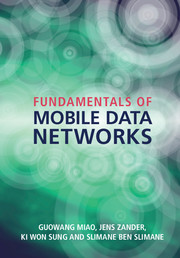Book contents
- Frontmatter
- Contents
- Preface
- Acronyms
- Notations
- 1 Introduction
- 2 Wireless network models
- 3 Medium access control
- 4 Scheduling
- 5 Principles of cellular systems
- 6 Transmitter power control
- 7 Interference management
- 8 Association and handover
- 9 Energy-efficient design
- 10 Long term evolution
- 11 Wireless infrastructure economics
- About the authors
- Index
- References
7 - Interference management
Published online by Cambridge University Press: 05 March 2016
- Frontmatter
- Contents
- Preface
- Acronyms
- Notations
- 1 Introduction
- 2 Wireless network models
- 3 Medium access control
- 4 Scheduling
- 5 Principles of cellular systems
- 6 Transmitter power control
- 7 Interference management
- 8 Association and handover
- 9 Energy-efficient design
- 10 Long term evolution
- 11 Wireless infrastructure economics
- About the authors
- Index
- References
Summary
Radio spectrum is a finite resource, and therefore has to be shared by multiple users. Such sharing or reuse of radio spectrum is a dominant feature of present-day wireless systems where a tremendous number of devices have wireless connectivity. If you use mobile Internet, particularly in a city, it is highly likely that the frequency channel assigned to you is also used by someone very near you. This sharing of radio spectrum inevitably causes interference between users due to the broadcast nature of the wireless medium. Managing the interference between the wireless links is one of the most important problems in wireless networks.
We have already discussed some basics of interference management in Chapter 5. Let's briefly recall the cellular principle here. In a cellular system, the whole service area is divided into cells, and each cell is covered by a base station or an access point. The mobile terminals in the same cell are exempt from the interference problem because they are given orthogonal resources, e.g., frequency channel, time, spreading code, or waveform. However, interference still takes place between the neighboring cells. Thus, what matters in the cellular systems is inter-cell interference. Frequency planning is applied to the cells so that the proper reuse distance can be maintained between the cells of the same frequency channel assignment.
The static frequency reuse presented in Chapter 5 is of course not the only method of managing interference in practical wireless systems. In fact, immense research work has been performed and is still ongoing in the field of inter-cell interference management. In this chapter, we will go deeper into this subject. First, the categories and elements of interference management techniques will be introduced in Section 7.1. Then, in the subsequent sections, the three categories of interference management techniques, namely interference avoidance, interference randomization and interference cancellation, will be further discussed with examples. Finally, interference management for small cells and heterogeneous networks is presented in Section 7.5. Note that interference management is a vast research area. This chapter only scratches the surface of the field.
Classification of interference management techniques
We will give a brief overview of interference management before looking into specific techniques.
- Type
- Chapter
- Information
- Fundamentals of Mobile Data Networks , pp. 177 - 198Publisher: Cambridge University PressPrint publication year: 2016



